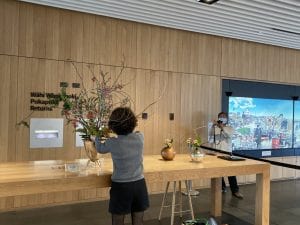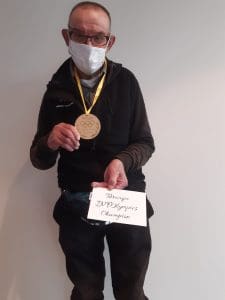Tūranga’s first INFOlympics Champion has been found and the champion is veteran quizzer Jeffrey Huffadine.
Jeffrey won the title of Tūranga INFOlympics Champion by performing the best in the INFOlympics Quiz which was part of the Focus on Wellbeing event hosted by Tūranga on 2 April.
Focus on Wellbeing featured a mix of reliable health information from providers including the Canterbury District Health Board and fun activities including the quiz and video games themed on information literacy. There was also a beautiful Ikebana (Japanese floral art) display and Tai Chi videos presented on a large screen. The Ikebana was designed by Mei-Chiung Wang and the Tai Chi videos featured Tianlong Cao. Mei-Chiung won an award for her Ikebana at the Ellerslie International Garden Show in Christchurch in 2010 and Tianlong won gold at a Chinese national competition in martial arts in 2020.
Tūranga staff intend to bring back Focus on Wellbeing on 2 July with planned live performances of Mau Rākau (traditional Maori weaponry) and Tai Chi as well as a new INFOlympics Quiz.
The quiz on 2 April had 10 questions themed on finding, assessing and using reliable information and the answers could be found on the five floors of Tūranga. Jeffrey is a regular visitor to Tūranga and likes to regularly test his general knowledge by completing online quizzes. For his efforts on April 2 Jeffrey won a $30 book voucher and the inaugural INFOlympics ‘gold’ medal.
He said completing quizzes regularly provided excellent preparation and he liked visiting Tūranga because it was an institution of reading, researching, training and lending. Quizzes appeal because they “get your brain ticking over” and Jeffrey said he intends defending his title at the next INFOlympics quiz.
Jeffrey has been a regular visitor to libraries for many years where he often caught up with friends or chatted with staff. Those he honed his research skills at included Linwood, South and New Brighton libraries and the post-quake temporary facilities on Peterborough and Manchester streets before Tūranga opened in 2018.
Tūranga’s INFOlympics champion thought he would buy a non-fiction book with his prize because he preferred books with facts and reliable information. In the end he chose The Salt Path by Raynor Winn.
Below are the INFOlympics quiz questions, answers and explanatory notes.
- Write down the physical address and/or mailing address of a New Zealand newspaper or magazine on He Hononga. Why is it important that New Zealand publications provide addresses? Answer: To give readers or subjects of articles an avenue for making a complaint if they believe journalistic ethics have been breached. Notes: A publication’s address should be on the publication page of magazines and the editorial page of a newspaper (some might have it on the second news page). Does your news source provide a complaints procedure?
- What is the purpose of the New Zealand Media Council? Answer: To hear complaints made against print, broadcast and digital media that are members of the council. Notes: The home page of the New Zealand Media Council (https://www.mediacouncil.org.nz/) has a succinct description of its purpose. Does your news source belong to an independent complaints body?
- Where on Hapori will you find a book on coding your own website? Answer: There are several books on the subject, including: “Code your own website” J 006.7 THE “The Quick Expert's Guide to Building A Website” J 006.7 MAR “Build your Own Website for Beginners” J 006.7 COW
- If your website uses information from other sources, why is it important to show where you got the information from? Answer: A. To show the information comes from other sources, ie other people’s work. Be responsible and give credits to other people’s work. B. To give readers the chance to refer back to the original source to find out more info. C. To show readers that you’ve done your research and your website is reliable. Notes: This libguide from MIT Libraries lists the reasons.
- A plaque on a large rock beside the Ōtākaro Avon River in Victoria Square has the following inscription: The Weeping Willows of Christchurch To Commemorate FRANÇOIS LE LIEVRE
Who first came to New Zealand on the French whaling ship ‘Le Nil’ in 1838. After landing in Akaroa he planted weeping willow cuttings taken from Napoleon’s grave on the Island of St. Helena. There is strong evidence to suggest that the first willows planted on the banks of the Avon River grew from cuttings taken from these trees.
Erected by his great-great-granddaughter Marie Emily Le Lievre (Akaroa) and the Christchurch City Council.
Unveiled by Councillor Sally Buck on 29th March 2001On Tuakiri find an entry in New Zealand’s Heritage (Volume 5) on Page 1821 which looks at the origins of the Willow trees. Does the writer support or challenge the idea that the cuttings are from St Helena Island? Answer: The writer challenges the idea the cuttings came from St Helena Island. Are you aware of another instance where history in the South Island has been reviewed?
- Kawakawa is a plant commonly used in Rongoā (Māori medicine) due to its variety of healing properties. Searching online find 3 ailments that kawakawa is used to treat. Then using a catalogue computer find a book on Māori herbal medicines. Does the book support the online answers you found and why is it important to check multiple sources? Answers: Pain relief, skin disorders (including rashes), cuts and bruises, bladder complaints. It’s important to think critically and explore multiple resources for a more detailed answer. Notes:- Book resources include: Maori Herbal and Healing – Riley Murdoch 581.634 RIL; Maori Healing Remedies – Riley Murdoch 581.634 RIL.
More about Māori medicine and kawakawa.
- What is a filter bubble? Hint: you might find an explanation at the website AllSides.com. Answer: A filter bubble occurs when someone is only exposed to news that confirms his or her beliefs, or solely interacts with like-minded peers. A similar term is “echo chamber”.
- Who wrote Extraordinary Popular Delusions and the Madness of Crowds and in what year did the writer die? Answer: Charles Mackay, 1889. Notes: The answer is in the library catalogue entry for the above title. This book demonstrates that misinformation has been a part of life for many years.
- You can use Adobe Photoshop in Auahatanga’s computer labs to edit images and there is a Linked-In Learning video tutorial on Photoshop on the Christchurch City Libraries’ website. Why do some media organisations ban altering pictures in their news coverage and others declare to their readers if they alter images in graphics (special images featuring text, pictures and art designed by graphic designers)? Answer: Those media organisations do not want to mislead their readers. Notes: The Stuff news website lists its policy on images. Does your source of news have a policy on the use of images?
- If you want to edit an image you found online, how will you know whether it is legal/within copyright or not? Answer: Look at Creative Commons licences, or notes added in the website where you found it. If there are no notes or CC licenses assume it is illegal to edit another person’s image. Notes: What do Creative Commons buttons do? on the Creative Commons FAQ site explains how a creator’s intellectual property is protected while still sharing their work.





Add a comment to: Tūranga regular wins gold at INFOlympics